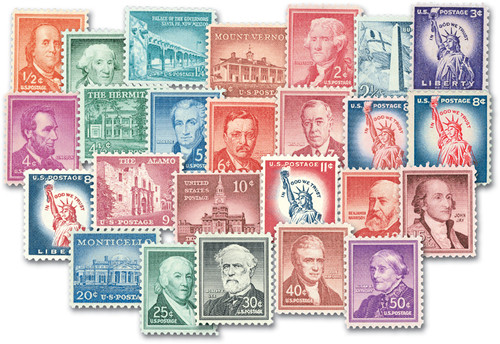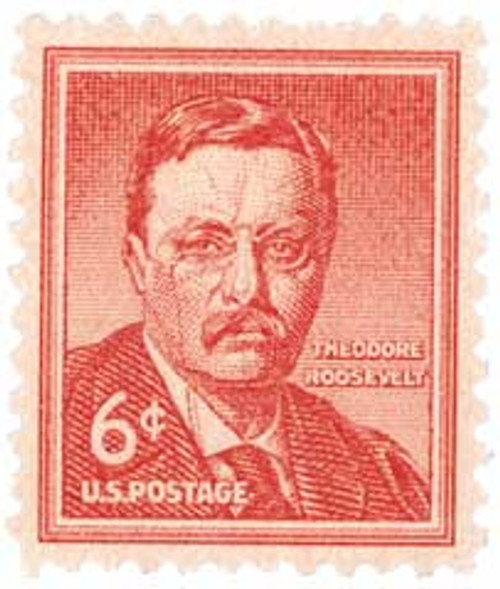
# 1035 FDC - 1954 Liberty Series - 3¢ Statue of Liberty
3¢ Statue of Liberty
Liberty Series
City: Albany, NY
Printed by: Bureau of Engraving and Printing
Printing Method: Rotary Press
Perforations: 11 x 10½
Color: Deep violet
“In God We Trust” Made Official U.S. Motto
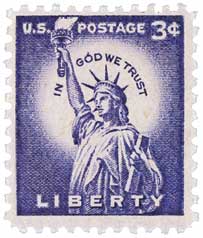
Although it had appeared on American coins for 92 years, “In God We Trust” didn’t become America’s official motto until July 30, 1956.
It’s roots in American tradition date back to the War of 1812, when Francis Scott Key included the phrase “And this be our motto: In God is our Trust” in his poem that became the national anthem, “Star-spangled Banner.” Fifty years later, as America was embroiled in Civil War, Reverend M.R. Watkinson requested that our coins include a statement recognizing God to “relieve us from the ignominy of heathenism.” He, and many others, wished to show that God sided with Union.
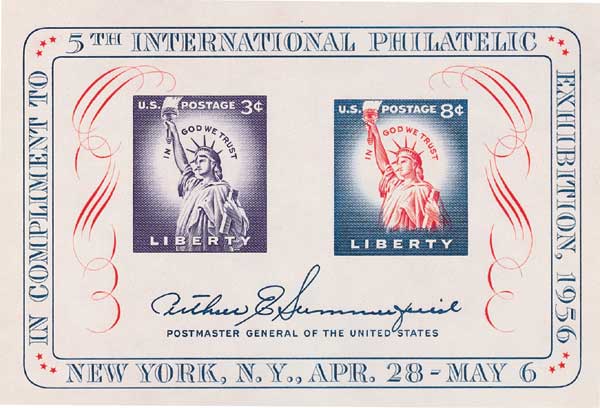
After special legislation was passed in April 1864, “In God We Trust” was minted on one- and two-cent coins. It appeared on various coins over the years, but not all of them. Following public outcry over its omission from a $20 coin in 1908, it was ordered that the phrase appear on all coins it had previously been minted on. It’s been on every U.S. coin produced since 1938.
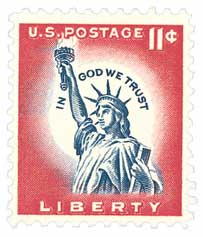
The phrase became a national matter in 1956 as America was involved in yet another conflict, the Cold War. American leaders wanted to distance us from the Soviet Union, which supported state atheism. When Florida representative Charles Edward Bennett proposed the legislation to the House, he stated that, “In these days when imperialistic and materialistic communism seeks to attack and destroy freedom, we should continually look for ways to strengthen the foundations of our freedom.”

So Congress passed a resolution declaring “In God We Trust” as the national motto. President Eisenhower signed it into law on July 30, 1956. The law also required the phrase to appear on all U.S. paper currency. “In God We Trust” now served as an alternative or replacement for America’s unofficial motto, E pluribus Unum (Out of many, one), which had been adopted as part of the Great Seal of the United States in 1782.
Interestingly, two years earlier, President Eisenhower had pushed for the inclusion of “under God” in the pledge of allegiance. At his 1954 Flag Day speech, Eisenhower stated that, “In this way we are reaffirming the transcendence of religious faith in America’s heritage and future; in this way we shall constantly strengthen those spiritual weapons which forever will be our country’s most powerful resource in peace and war.”
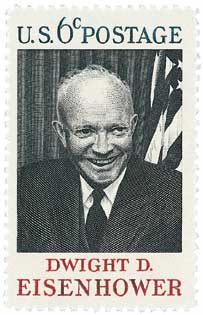
The phrase’s use and adoption hasn’t been without controversy. President Theodore Roosevelt objected to its use on coins as he considered it sacrilege. Many others believe it symbolizes government support of religion, though several court cases have ruled against that suggestion.
Our nation’s motto first appears on postage
A little over two years before this, America issued the first definitive stamp bearing this motto in April 1954. The stamp, pictured below, was the first definitive with religious significance. The stamp was issued at the request of thousands of Americans calling for such a stamp with religious ties.
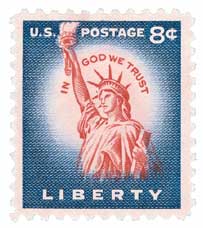
According to Arthur E. Summerfield, Postmaster General at the time, “The inscription “In God We Trust” sums up the religious faith that has always been and is today the bulwark of this Nation – and its greatest source of strength. This stamp rededicates our faith in the spiritual foundations upon which our government and our nation rests and without which no government or nation could endure. Since this new stamp will be used primarily for the first ounce of regular international mail, it is ‘a postal ambassador’ which will be abroad at the rate of about 200 million or more stamps a year.”
The stamp was unveiled in a nationwide television event attended by President Eisenhower, Secretary of State John Foster Dulles, and leaders of religious groups.
3¢ Statue of Liberty
Liberty Series
City: Albany, NY
Printed by: Bureau of Engraving and Printing
Printing Method: Rotary Press
Perforations: 11 x 10½
Color: Deep violet
“In God We Trust” Made Official U.S. Motto

Although it had appeared on American coins for 92 years, “In God We Trust” didn’t become America’s official motto until July 30, 1956.
It’s roots in American tradition date back to the War of 1812, when Francis Scott Key included the phrase “And this be our motto: In God is our Trust” in his poem that became the national anthem, “Star-spangled Banner.” Fifty years later, as America was embroiled in Civil War, Reverend M.R. Watkinson requested that our coins include a statement recognizing God to “relieve us from the ignominy of heathenism.” He, and many others, wished to show that God sided with Union.

After special legislation was passed in April 1864, “In God We Trust” was minted on one- and two-cent coins. It appeared on various coins over the years, but not all of them. Following public outcry over its omission from a $20 coin in 1908, it was ordered that the phrase appear on all coins it had previously been minted on. It’s been on every U.S. coin produced since 1938.

The phrase became a national matter in 1956 as America was involved in yet another conflict, the Cold War. American leaders wanted to distance us from the Soviet Union, which supported state atheism. When Florida representative Charles Edward Bennett proposed the legislation to the House, he stated that, “In these days when imperialistic and materialistic communism seeks to attack and destroy freedom, we should continually look for ways to strengthen the foundations of our freedom.”

So Congress passed a resolution declaring “In God We Trust” as the national motto. President Eisenhower signed it into law on July 30, 1956. The law also required the phrase to appear on all U.S. paper currency. “In God We Trust” now served as an alternative or replacement for America’s unofficial motto, E pluribus Unum (Out of many, one), which had been adopted as part of the Great Seal of the United States in 1782.
Interestingly, two years earlier, President Eisenhower had pushed for the inclusion of “under God” in the pledge of allegiance. At his 1954 Flag Day speech, Eisenhower stated that, “In this way we are reaffirming the transcendence of religious faith in America’s heritage and future; in this way we shall constantly strengthen those spiritual weapons which forever will be our country’s most powerful resource in peace and war.”

The phrase’s use and adoption hasn’t been without controversy. President Theodore Roosevelt objected to its use on coins as he considered it sacrilege. Many others believe it symbolizes government support of religion, though several court cases have ruled against that suggestion.
Our nation’s motto first appears on postage
A little over two years before this, America issued the first definitive stamp bearing this motto in April 1954. The stamp, pictured below, was the first definitive with religious significance. The stamp was issued at the request of thousands of Americans calling for such a stamp with religious ties.

According to Arthur E. Summerfield, Postmaster General at the time, “The inscription “In God We Trust” sums up the religious faith that has always been and is today the bulwark of this Nation – and its greatest source of strength. This stamp rededicates our faith in the spiritual foundations upon which our government and our nation rests and without which no government or nation could endure. Since this new stamp will be used primarily for the first ounce of regular international mail, it is ‘a postal ambassador’ which will be abroad at the rate of about 200 million or more stamps a year.”
The stamp was unveiled in a nationwide television event attended by President Eisenhower, Secretary of State John Foster Dulles, and leaders of religious groups.






